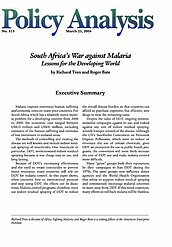Malaria imposes enormous human suffering and economic costs on many poor countries. For South Africa, which has a relatively minor malaria problem for a developing country, from 2000 to 2002 the economic cost ranged between US$15 million and US$41 million, excluding estimates of the human suffering and estimates of lost investment in malarial areas.
The methods of controlling and treating the disease are well known and include indoor residual spraying of insecticides. One insecticide in particular, DDT, revolutionized indoor residual spraying because it was cheap, easy to use, and long lasting.
Because of DDT’s continuing effectiveness and the need to rotate insecticides to prevent insect resistance, many countries still rely on DDT for malaria control. As this paper shows, when countries bow to international pressure and stop using DDT, the effects can be disastrous. Malaria control programs, therefore, must use indoor residual spraying of DDT to reduce the overall disease burden, so that countries can afford to purchase expensive, but effective, new drugs to treat the remaining cases.
Despite the value of DDT, ongoing environmentalist campaigns against its use, and indeed against any sort of indoor residual spraying, severely hamper control of the disease. Although the UN’s Stockholm Convention on Persistent Organic Pollutants, which aims to reduce or eliminate the use of certain chemicals, gives DDT an exemption for use in public health programs, the convention will most likely increase the cost of DDT use and make malaria control more difficult.
Many “green” groups built their reputations by their campaigns to ban DDT during the 1970s. The same groups now influence donor agencies and the World Health Organization that refuse to support indoor residual spraying and continuously encourage malarial countries to move away from DDT. If this trend continues, many efforts to roll back malaria will be fruitless.
About the Authors

This work is licensed under a Creative Commons Attribution-NonCommercial-ShareAlike 4.0 International License.
